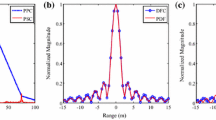Abstract
Ternary sequences have superior merit factors but they cannot be transmitted with existing technology. It is proposed that a ternary sequence be coded into a binary sequence for the purpose of transmission. On reception it can be processed as a binary sequence as received and also decoded into a ternary sequence. These two interpretations provide a coincidence detection scheme for efficient target detection provided that the corresponding signal design problem is solved. Such an algorithm is developed by taking the merit factor as desideratum and the Hamming scan as optimization technique. Merit factor values obtained in some cases are further improved by implementing a back-tracking algorithm for bi-alphabetic sequence.
Similar content being viewed by others
References
Barker R H 1953 Group synchronization of binary digital systems. InCommunication theory (ed.) W Jackson (London: Butterworths)
Beenker G F M, Claasen TAC M, Heime P W C 1985 Binary sequences with a maximally flat amplitude spectrum.Phillips J. Res. 40: 289–304
Bernasconi J 1987 Low autocorrelation binary sequences: statistical mechanics and configuration space analysis.J. Phys. 48: 559–567
Bernasconi J 1988 Optimization problems and statistical mechanics.Proc. Workshop on Chaos and Complexity, 1987 (Torino: World Scientific)
Baumert L D 1971Cyclic difference sets (Berlin: Springer-Verlag)
Cook C E, Bernfeld M 1967Radar signals (New York: Academic Press)
De Groot C, Wurtz D, Hoffman K H 1992 Low autocorrelation binary sequences: exact enumeration and optimization by evolutionary stratigies.Optimization 23: 369–384
Deergha Rao K, Sridhar G 1995 Improving performance in pulse radar detection using neural networks.IEEE Trans. Aerosp. Electron. Syst. 30: 1193–1198
Golay M J E 1972 A class of finite binary sequences with alternate autocorrelation values equal to zero.IEEE Trans. Inf. Theory IT-18: 449–450
Golay M J E 1977 Sieves for low autocorrelation binary sequences.IEEE Trans. Inf. Theory IT-23: 43–51
Golay M J E 1982 The merit factor of long low autocorrelation binary sequences.IEEE Trans. Inf. Theory IT-28: 543–549
Golay M J E 1983 The merit factor of Legendré sequences.IEEE Trans. Inf. Theory IT-29: 934–936
Golay MJ E, Harris D 1990 A new search for skew-symmetric binary sequences with optimal merit factors.IEEE Trans. Inf. Theory 36: 1163–1166
Hoholdt T, Justesen J 1988 Determination of the merit factor of Legendré sequences.IEEE Trans. Inf. Theory IT-34: 161–164
Hoholdt T, Jensen H E, Justesen J 1985 Aperiodic correlations and the merit factor of a class of binary sequences.IEEE Trans. Inf. Theory IT-31: 549–552
Jensen J M, Jensen H E, Hoholdt T 1991 The merit factor of binary sequences related to difference sets.IEEE Trans. Inf. Theory IT-37: 617–626
Kerdock A M, Meyar R, Bass D 1986 Longest binary pulse compression codes with given peak side lobe levels.Proc. IEEE 74: 366
Kwan H K, Lee C K 1989 Pulse radar detection using a multilayer neural network.Proc. Int. Joint Conf. on Neural Networks, Washington, 2: 75–85
Kwan H K, Lee C K 1993 A neural network approach to pulse radar detection.IEEE Trans. Aerosp. Electron. Syst. 29: 9–21
Moharir P S 1975 Generation of the approximation to binary white noise.J. IETE 21: 5–7
Moharir P S 1998 Non-linear non gaussian inversion.Inverse methods: general principles and applications to earth sciences (eds) N K Indira, P K Gupta (New Delhi: Narosa)
Moharir P S, Subba Rao K 1997 Nonbinary sequences with superior merit factors.IETE J. Res. 1: 49–53
Moharir P S, Maru V M, Singh R 1996 S-K-H algorithm for signal design.Electron. Lett. 32: 1648–1649
Moharir P S, Maru V M, Singh R 1997a Bi-parental product algorithm for coded wave form design in radar.Sādhanā 22: 589–599
Moharir P S, Maru V M, Singh R 1997b Untrapping techniques for radar signal design.Electron. Lett. 33: 631–633
Moharir P S, Maru V M, Singh R 1998 Simonization for signal design.Sādhanā 23: 351–358
Newmann D J, Byrnes J S 1990 The L norm of polynomial with coefficients+1.Am. Math. Mon. 97: 42–45
Singh R, Moharir P S, Maru V M 1996 Eugenic algorithm-based search for ternary pulse compression sequences.J. Inst. Electron. Telecommun. Eng. 42: 11–19
Turyn R 1963 Optimum code study. Sylvania Electric Systems Rep. F 437-1
Turyn R 1968 Sequences with small correlation. InError correcting codes (ed.) H B Mann (New York: Wiley) pp 195–228
Author information
Authors and Affiliations
Rights and permissions
About this article
Cite this article
Pasha, I.A., Moharir, P.S. & Rao, N.S. Bi-alphabetic pulse compression radar signal design. Sadhana 25, 481–488 (2000). https://doi.org/10.1007/BF02703629
Received:
Issue Date:
DOI: https://doi.org/10.1007/BF02703629




